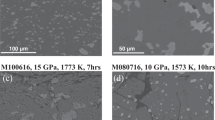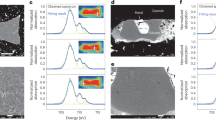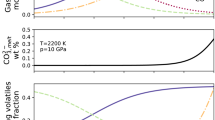Abstract
The mantle comprises nearly three-quarters of Earth’s volume and through convection connects the deep interior with the lithosphere and atmosphere. The composition of the mantle determines volcanic emissions, which are intimately linked to evolution of the primitive atmosphere. Fundamental questions remain on how and when the proto-Earth mantle became oxidized, and whether redox state is homogeneous or developed large-scale structures. Here we present experiments in which we subjected two synthetic samples of nearly identical composition that are representative of the lower mantle (enstatite chondrite), but synthesized under different oxygen fugacities, to pressures and temperatures up to 90 GPa and 2,400 K. In addition to the mineral bridgmanite, compression of the more reduced material also produced Al2O3 as a separate phase, and the resulting assemblage is about 1 to 1.5% denser than in experiments with the more oxidized material. Our geodynamic simulations suggest that such a density difference can cause a rapid ascent and accumulation of oxidized material in the upper mantle, with descent of the denser reduced material to the core–mantle boundary. We suggest that the resulting heterogeneous redox conditions in Earth’s interior can contribute to the large low-shear velocity provinces in the lower mantle and the evolution of atmospheric oxygen.
This is a preview of subscription content, access via your institution
Access options
Subscribe to this journal
Receive 12 print issues and online access
$259.00 per year
only $21.58 per issue
Buy this article
- Purchase on Springer Link
- Instant access to full article PDF
Prices may be subject to local taxes which are calculated during checkout






Similar content being viewed by others
References
Brocks, J. J., Logan, G. A., Buick, R. & Summons, R. E. Archean molecular fossils and the early rise of eukaryotes. Science 285, 1033–1036 (1999).
Crowe, S. A. et al. Atmospheric oxygenation three billion years ago. Nature 501, 535–538 (2013).
Planavsky, N. J. et al. Evidence for oxygenic photosynthesis half a billion years before the Great Oxidation Event. Nature Geosci. 7, 283–286 (2014).
Holland, H. D. Volcanic gases, black smokers, and the Great Oxidation Event. Geochim. Cosmochim. Acta 66, 3811–3826 (2002).
Kasting, J. F., Eggler, D. H. & Raeburn, S. P. Mantle redox evolution and the oxidation state of the Archean atmosphere. J. Geol. 101, 245–257 (1993).
Li, Z.-X. A. & Lee, C.-T. A. The constancy of upper mantle fO2 through time inferred from V/Sc ratios in basalts. Earth Planet. Sci. Lett. 228, 483–493 (2004).
Woodland, A. B. & Koch, M. Variation in oxygen fugacity with depth in the upper mantle beneath the Kaapvaal craton, Southern Africa. Earth Planet. Sci. Lett. 214, 295–310 (2003).
McCammon, C. & Kopylova, M. G. A redox profile of the Slave mantle and oxygen fugacity control in the cratonic mantle. Contrib. Mineral. Petrol. 148, 55–68 (2004).
Wood, B. J., Walter, M. J. & Wade, J. Accretion of the Earth and segregation of its core. Nature 441, 825–833 (2006).
Frost, D. J. et al. Experimental evidence for the existence of iron-rich metal in the Earth’s lower mantle. Nature 428, 409–412 (2004).
Mason, B. The enstatite chondrites. Geochim. Cosmochim. Acta 30, 23–39 (1966).
Javoy, M. The integral enstatite chondrite model of the Earth. Geophys. Res. Lett. 22, 2219–2222 (1995).
Tschauner, O., Ma, C., Beckett, J. R. & Prescher, C. Discovery of bridgmanite, the most abundant mineral in Earth, in a shocked meteorite. Science 346, 1100–1102 (2014).
Ballaran, T. B. et al. Effect of chemistry on the compressibility of silicate perovskite in the lower mantle. Earth Planet. Sci. Lett. 333–334, 181–190 (2012).
Andrault, D., Fiquet, G., Guyot, F. & Hanfland, M. Pressure-induced Landau-type transition in stishovite. Science 282, 720–724 (1998).
Abràmoff, M. D., Magalhães, P. J. & Ram, S. J. Image processing with ImageJ. Biophoton. Int. 11, 36–43 (2004).
Palke, A. C., Stebbins, J. F., Frost, D. J. & McCammon, C. A. Incorporation of Fe and Al in MgSiO3 perovskite: an investigation by 27Al and 29Si NMR spectroscopy. Am. Mineral. 97, 1955–1964 (2012).
Catalli, K. et al. Spin state of ferric iron in MgSiO3 perovskite and its effect on elastic properties. Earth Planet. Sci. Lett. 289, 68–75 (2010).
Dorfman, S. M., Meng, Y., Prakapenka, V. B. & Duffy, T. S. Effects of Fe-enrichment on the equation of state and stability of (Mg, Fe)SiO3 perovskite. Earth Planet. Sci. Lett. 361, 249–257 (2013).
Fei, Y., Virgo, D., Mysen, B. O., Wang, Y. & Mao, H.-K. Temperature-dependent electron delocalization in (Mg, Fe)SiO3 perovskite. Am. Mineral. 79, 826–837 (1994).
Hummer, D. R. & Fei, Y. Synthesis and crystal chemistry of Fe3+-bearing (Mg, Fe3+)(Si, Fe3+)O3 perovskite. Am. Mineral. 97, 1915–1921 (2012).
Lundin, S. et al. Effect of Fe on the equation of state of mantle silicate perovskite over 1Mbar. Phys. Earth Planet. Inter. 168, 97–102 (2008).
Parise, J. B., Wang, Y., Yeganeh-Haeri, A., Cox, D. E. & Fei, Y. Crystal structure and thermal expansion of (Mg, Fe)SiO3 perovskite. Geophys. Res. Lett. 17, 2089–2092 (1990).
Wang, Y., Weidner, D. J., Liebermann, R. C. & Zhao, Y. P-V-T equation of state of (Mg, Fe)SiO3 perovskite: constraints on composition of the lower mantle. Phys. Earth Planet. Inter. 83, 13–40 (1994).
Cottaar, S., Heister, T., Rose, I. & Unterborn, C. BurnMan: a lower mantle mineral physics toolkit. Geochem. Geophys. Geosyst. 15, 1164–1179 (2014).
Brown, J. M. & Shankland, T. J. Thermodynamic parameters in the Earth as determined from seismic profiles. Geophys. J. R. Astron. Soc. 66, 579–596 (1981).
Dziewonski, A. M. & Anderson, D. L. Preliminary reference Earth model. Phys. Earth Planet. Inter. 25, 297–356 (1981).
Ishii, M. & Tromp, J. Constraining large-scale mantle heterogeneity using mantle and inner-core sensitive normal modes. Phys. Earth Planet. Inter. 146, 113–124 (2004).
Garnero, E. J. & McNamara, A. K. Structure and dynamics of Earth’s lower mantle. Science 320, 626–628 (2008).
Canil, D. Vanadium partitioning and the oxidation state of Archaean komatiite magmas. Nature 389, 842–845 (1997).
Delano, J. W. Redox history of the Earth’s interior since ∼3900 Ma: implications for prebiotic molecules. Orig. Life Evolut. Biosph. 31, 311–341 (2001).
Torsvik, T. H., Burke, K., Steinberger, B., Webb, S. J. & Ashwal, L. D. Diamonds sampled by plumes from the core–mantle boundary. Nature 466, 352–355 (2010).
Ringwood, A. E. Chemical evolution of the terrestrial planets. Geochim. Cosmochim. Acta 30, 41–104 (1966).
Fei, Y. et al. Toward an internally consistent pressure scale. Proc. Natl Acad. Sci. USA 104, 9182–9186 (2007).
Jayaraman, A. Diamond anvil cell and high-pressure physical investigations. Rev. Mod. Phys. 55, 1–44 (1983).
Du, Z. et al. Using stepped anvils to make even insulation layers in laser-heated diamond-anvil cell samples. Rev. Sci. Instrum. 86, 095103 (2015).
Du, Z., Amulele, G., Robin Benedetti, L. & Lee, K. K. M. Mapping temperatures and temperature gradients during flash heating in a diamond-anvil cell. Rev. Sci. Instrum. 84, 075111 (2013).
Akahama, Y. & Kawamura, H. Pressure calibration of diamond anvil Raman gauge to 310 GPa. J. Appl. Phys. 100, 043516 (2006).
Hammersley, A. P., Svensson, S. O., Hanfland, M., Fitch, A. N. & Häusermann, D. Two-dimensional detector software: from real detector to idealised image or two-theta scan. High Press. Res. 14, 235–248 (1996).
Larson, A. C. & Dreele Von, R. B. General Structure Analysis System (GSAS) (Los Alamos National Laboratory, 2004).
Toby, B. H. EXPGUI, a graphical user interface for GSAS. J. Appl. Crystallogr. 34, 210–213 (2001).
Ross, N. L., Shu, J. F., Hazen, R. M. & Gasparik, T. High-pressure crystal chemistry of stishovite. Am. Mineral. 75, 739–747 (1990).
Du, Z. & Lee, K. K. M. High-pressure melting of MgO from (Mg, Fe)O solid solutions. Geophys. Res. Lett. 41, 8061–8066 (2014).
Stebbins, J. F., Kojitani, H., Akaogi, M. & Navrotsky, A. Aluminum substitution in MgSiO3 perovskite: investigation of multiple mechanisms by 27Al NMR. Am. Mineral. 88, 1161–1164 (2003).
McNamara, A. K., Garnero, E. J. & Rost, S. Tracking deep mantle reservoirs with ultra-low velocity zones. Earth Planet. Sci. Lett. 299, 1–9 (2010).
Moresi, L., Zhong, S. & Gurnis, M. The accuracy of finite element solutions of Stokes’ flow with strongly varying viscosity. Phys. Earth Planet. Inter. 97, 83–94 (1996).
Li, M., McNamara, A. K. & Garnero, E. J. Chemical complexity of hotspots caused by cycling oceanic crust through mantle reservoirs. Nature Geosci. 7, 366–370 (2014).
Tackley, P. J. & King, S. D. Testing the tracer ratio method for modeling active compositional fields in mantle convection simulations. Geochem. Geophys. Geosyst. 4, 8302 (2003).
Wohlers, A. & Wood, B. J. A Mercury-like component of early Earth yields uranium in the core and high mantle 142Nd. Nature 520, 337–340 (2015).
Acknowledgements
We thank R. Weber and S. Tumber for glass synthesis; Z. Du, A. McNamara and N. J. Planavsky for discussions; G. Amulele, J. Eckert, Z. Jiang, M. Rooks, F. Camino and Y. Yang for technical support. We thank the staff and beamline scientists at GSECARS and HPCAT—in particular, V. Prakapenka, C. Prescher and S. Tkachev. We thank L. Zhang and H. K. Mao for sharing beam time. This work was funded by an NSF CAREER grant to K.K.M.L. (EAR-0955824). M.L. is supported by the NSF grant EAR-1338810. We thank CIDER 2014 for providing this opportunity for multi-disciplinary collaboration (NSF FESD grant 1135452). FIB use was supported by YINQE (NSF MRSEC DMR 1119826) and by the Center for Functional Nanomaterials, Brookhaven National Laboratory (US DOE-BES under Contract No. DE-AC02-98CH10886). EPMA was funded by the NSF (EAR-0744154) and Yale University. Portions of this work were performed at GSECARS (NSF EAR-1128799, DOE DE-FG02-94ER14466, and NSF EAR 11-57758 for gas loading system), and HPCAT (DE-NA0001974, DE-FG02-99ER45775, with partial instrumentation funding by NSF). This research used resources of the APS, a US DOE Office of Science User Facility operated for the DOE Office of Science by ANL under Contract No. DE-AC02-06CH11357.
Author information
Authors and Affiliations
Contributions
T.G. and K.K.M.L. designed the experiments and conducted the analysis; T.G. performed the experiments, and designed geodynamical models with M.L., who also performed the geodynamical simulations. C.M. performed the Mössbauer analyses and interpretation. All authors contributed in the writing of the manuscript. K.K.M.L. supervised the project.
Corresponding authors
Ethics declarations
Competing interests
The authors declare no competing financial interests.
Supplementary information
Supplementary Information
Supplementary Information (PDF 1515 kb)
Rights and permissions
About this article
Cite this article
Gu, T., Li, M., McCammon, C. et al. Redox-induced lower mantle density contrast and effect on mantle structure and primitive oxygen. Nature Geosci 9, 723–727 (2016). https://doi.org/10.1038/ngeo2772
Received:
Accepted:
Published:
Issue Date:
DOI: https://doi.org/10.1038/ngeo2772
This article is cited by
-
Earth’s mantle composition revealed by mantle plumes
Nature Reviews Earth & Environment (2023)
-
Moon-forming impactor as a source of Earth’s basal mantle anomalies
Nature (2023)
-
Formation of large low shear velocity provinces through the decomposition of oxidized mantle
Nature Communications (2021)
-
Iron diapirs entrain silicates to the core and initiate thermochemical plumes
Nature Communications (2018)
-
Valence and spin states of iron are invisible in Earth’s lower mantle
Nature Communications (2018)



